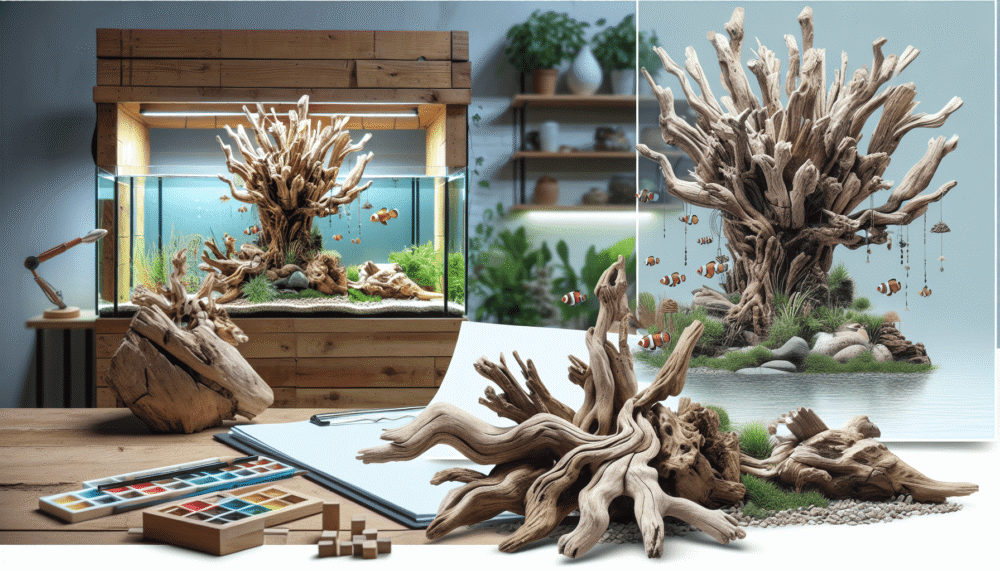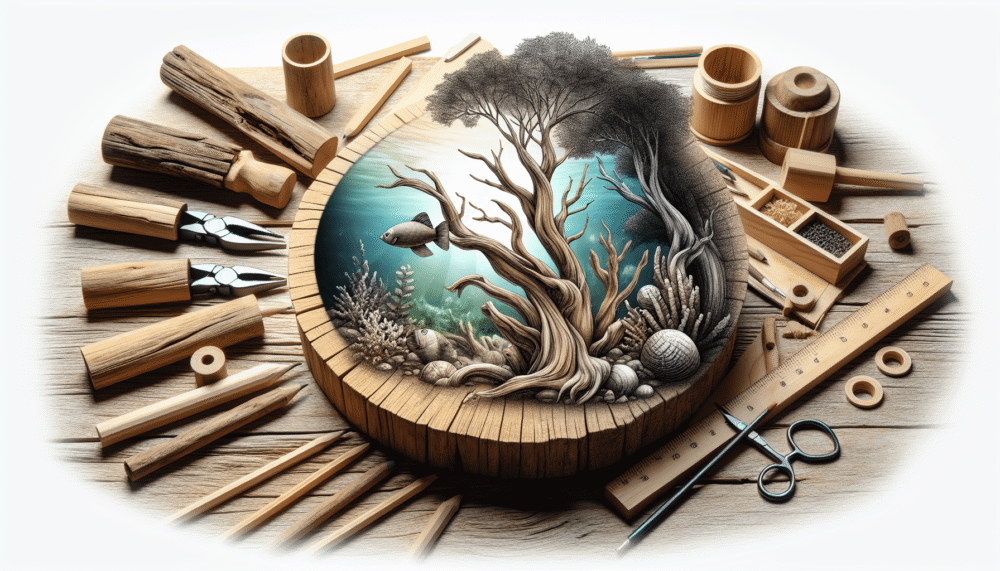Have you ever come across a beautiful piece of driftwood and wondered how to attach it together? Whether you’re looking to create a unique piece of home decor or incorporate driftwood into a craft project, attaching driftwood together can be a fun and creative way to bring nature’s beauty into your design. In this article, we will explore various techniques and materials that you can use to securely attach driftwood together, allowing you to unleash your creativity and create stunning pieces that showcase the natural charm of driftwood.
Types of Driftwood
Natural Driftwood
Natural driftwood refers to pieces of wood that have been washed up on shores or riverbanks. It is characterized by its weathered appearance and unique shapes, which are formed through the natural processes of erosion and exposure to water. Natural driftwood is often favored for its authenticity and rustic charm, making it a popular choice for various artistic and decorative purposes.
Processed Driftwood
Processed driftwood, on the other hand, is wood that has undergone some form of treatment or modification to enhance its durability and appearance. This can include processes such as kiln-drying, bleaching, or sanding. Processed driftwood is often more uniform in shape and texture, allowing for easier attachment and manipulation. It is commonly used in crafts, furniture making, and landscaping projects.
Preparation for Attaching Driftwood
Gather necessary materials
Before you begin attaching driftwood together, it’s important to gather the necessary materials. This may include screws, nails, adhesive, wire, rope or twine, a measuring tape, a drill, sandpaper, and a suitable adhesive for the type of driftwood you are working with.
Inspect and clean the driftwood
Inspect the driftwood for any signs of damage or decay. If you come across any soft or rotten areas, it’s best to avoid using those sections for attachment. Clean the driftwood by gently brushing off any dirt or debris using a soft-bristled brush or a cloth.
Determine the design or structure
Before attaching the driftwood, take some time to visualize and plan the design or structure you want to create. This will help you determine the placement and positioning of the driftwood pieces, as well as the most suitable attachment method.

Choosing the Right Attachment Method
Using Screws and Nails
Screws and nails are a popular and secure method for attaching driftwood together. When using screws or nails, it’s important to ensure that you choose the appropriate size and type for the job. Stainless steel or galvanized hardware is recommended to prevent rusting in outdoor applications.
Using Adhesive
Adhesives can provide a strong bond when attaching driftwood. However, it’s crucial to select an adhesive that is suitable for the specific type of driftwood you are working with. Epoxy, wood glue, or marine adhesive are often recommended choices for their strong bonding properties.
Using Wire
Wire can be used to create a versatile and flexible attachment method for driftwood. Choose a wire that is strong enough to support the weight of the driftwood, such as stainless steel or copper wire. Wrapping and securing the wire around the driftwood pieces will provide a secure connection.
Using Rope or Twine
Rope or twine can add a rustic and natural look to your driftwood attachment. Opt for a sturdy and durable rope or twine, such as hemp or jute, to ensure a secure hold. Creating knots to secure the driftwood pieces together will provide a simple yet effective attachment method.
Attaching Driftwood with Screws and Nails
Measure and mark the attachment points
Before attaching the driftwood with screws or nails, measure and mark the desired attachment points on the wood. You can use a measuring tape and a pencil to ensure accuracy.
Predrill holes
To prevent the wood from splitting, it’s important to predrill holes before inserting screws or nails. Use a drill bit that is slightly smaller than the diameter of the hardware to create pilot holes.
Attach the driftwood
Position the driftwood pieces according to your design or structure plan and align the predrilled holes. Securely attach the pieces together by driving screws or nails into the prepared holes using a screwdriver or hammer. Be careful not to overtighten, as this may damage the wood.

Attaching Driftwood with Adhesive
Select a suitable adhesive
When attaching driftwood with adhesive, it’s crucial to choose an appropriate adhesive that will provide a strong and durable bond. Depending on the type of driftwood and the intended use, options such as epoxy, wood glue, or marine adhesive can be ideal choices.
Apply the adhesive
Follow the instructions on the adhesive packaging to ensure proper application. Apply the adhesive to the surfaces of the driftwood that will be joined together. Be generous with the amount of adhesive, but avoid excess that may squeeze out and create a messy appearance.
Join the driftwood pieces
Press the adhesive-coated surfaces of the driftwood together firmly, making sure they align according to your design or structure plan. Apply clamps or use heavy objects to help hold the pieces in place while the adhesive cures. Allow sufficient drying time before handling or further manipulating the attached driftwood.
Attaching Driftwood with Wire
Choose the right wire
When using wire to attach driftwood, it’s important to select a wire that is strong enough to support the weight of the pieces. Stainless steel or copper wire are commonly used due to their strength and resistance to rust. Choose a gauge of wire that matches the thickness and size of the driftwood.
Wrap and secure the wire around the driftwood
Start by wrapping the wire around the driftwood pieces, making sure to cross it over itself for added strength. Twist the wire tightly to secure it in place, leaving enough excess to create additional wraps or twists if necessary. Continue wrapping and securing the wire until the driftwood pieces are firmly attached.
Attaching Driftwood with Rope or Twine
Select sturdy and durable rope or twine
When attaching driftwood with rope or twine, it’s important to choose a material that is sturdy and durable. Hemp or jute rope, or thick twine, are popular choices as they provide a natural and rustic aesthetic while offering a secure hold.
Create knots to secure the driftwood
To attach driftwood with rope or twine, start by tying a strong knot at one end of the material. Position the driftwood pieces according to your design or structure plan and loop the rope or twine around the pieces to hold them together. Tie secure knots at each connection point, ensuring the pieces are tightly held in place.
Strengthening the Attachment
Using additional support
For larger or heavier driftwood pieces or structures, additional support may be necessary. This can be achieved by adding additional screws, nails, or adhesive at strategic points to reinforce the attachment.
Reinforcing with brackets or corner pieces
Brackets or corner pieces can be used to provide additional support and stability to attached driftwood. Position the brackets or corner pieces at key connection points and secure them to the driftwood using screws or nails.
Using epoxy or wood filler
If you notice any gaps or areas that require additional reinforcement, epoxy or wood filler can be used. Fill the gaps with the chosen material and allow it to dry or cure according to the manufacturer’s instructions. This will strengthen the attachment and provide a seamless finish.
Finishing and Enhancing the Look
Sanding the driftwood
After the driftwood pieces are securely attached, consider sanding the surfaces to create a smoother and more polished appearance. Use sandpaper with a medium grit and lightly sand in the direction of the wood grain. Be cautious not to over-sand and lose the natural texture and character of the driftwood.
Staining or painting the driftwood
To enhance the color and protect the driftwood, staining or painting can be applied. Choose a stain or paint that is suitable for the type of wood and desired outcome. Apply the stain or paint evenly across the driftwood surface, following the manufacturer’s instructions. Allow sufficient drying time before handling or displaying the attached driftwood.
Sealing the driftwood
To prolong the lifespan of the attached driftwood and protect it from moisture, sealing is recommended. Apply a clear wood sealer or varnish to all exposed surfaces, ensuring thorough coverage. This will provide an added layer of protection against the elements and maintain the integrity of the attachment.
Displaying and Using Attached Driftwood
Choosing a suitable location
When displaying attached driftwood, consider the environment and purpose of the piece. Ensure that the location provides sufficient support and stability for the attached driftwood, especially if it is a larger or heavier structure.
Creating a driftwood sculpture
Attached driftwood pieces can be arranged and manipulated to create stunning sculptures. Explore different shapes and forms by interlocking and overlapping the attached driftwood. Experiment with various attachment methods to achieve the desired look and balance.
Making functional driftwood furniture
Attached driftwood can also be used to create unique and functional furniture pieces. From coffee tables to shelves, the natural and organic look of driftwood adds a touch of character to any space. Ensure that the attachment method used provides a sturdy and secure structure for the furniture piece.
By following these steps and experimenting with different attachment methods, you can successfully attach driftwood together and create beautiful and unique pieces for various artistic, decorative, or functional purposes. Let your imagination and creativity flow as you explore the endless possibilities that driftwood has to offer. Enjoy the process and have fun with your driftwood projects!

